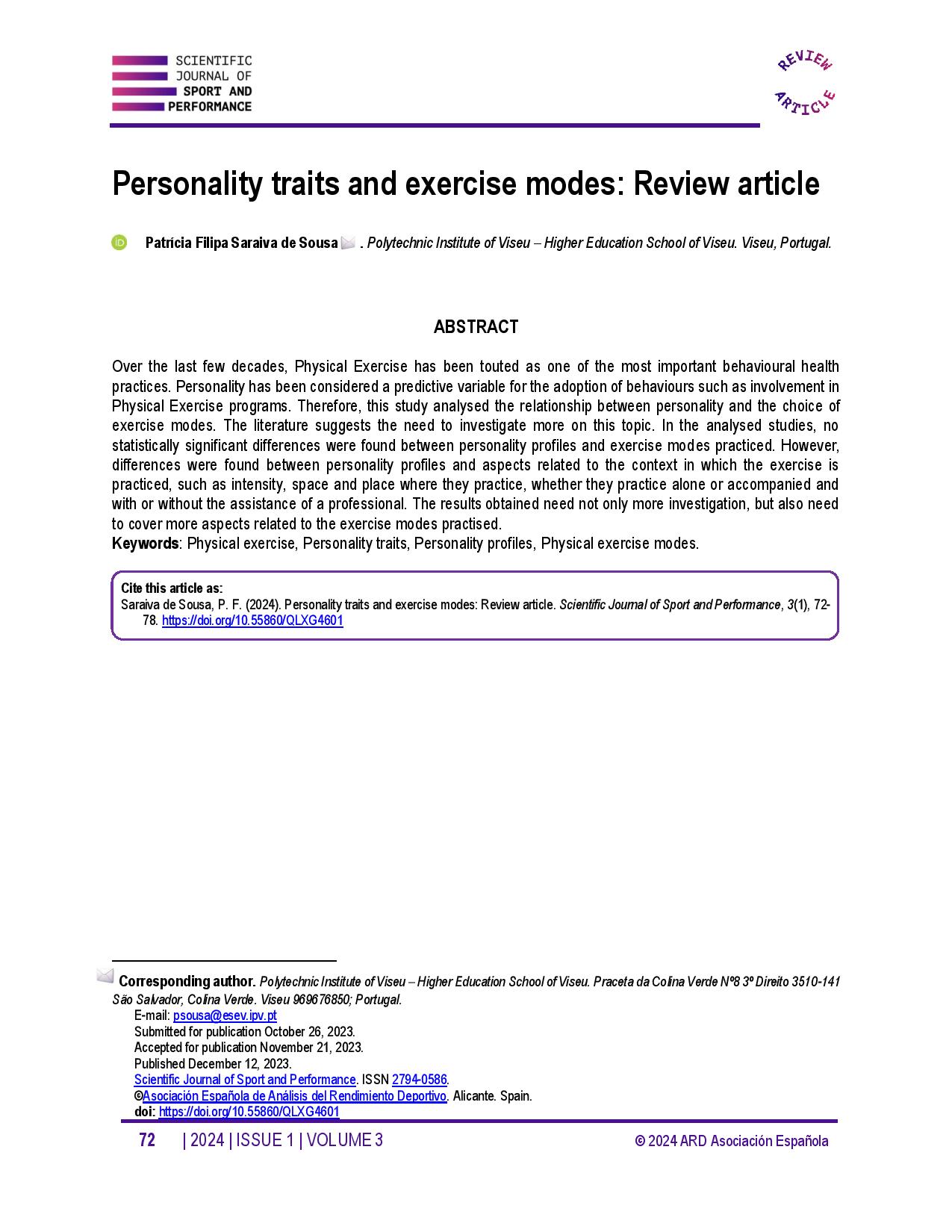Personality traits and exercise modes Review article
Main Article Content
Abstract
Over the last few decades, Physical Exercise has been touted as one of the most important behavioural health practices. Personality has been considered a predictive variable for the adoption of behaviours such as involvement in Physical Exercise programs. Therefore, this study analysed the relationship between personality and the choice of exercise modes. The literature suggests the need to investigate more on this topic. In the analysed studies, no statistically significant differences were found between personality profiles and exercise modes practiced. However, differences were found between personality profiles and aspects related to the context in which the exercise is practiced, such as intensity, space and place where they practice, whether they practice alone or accompanied and with or without the assistance of a professional. The results obtained need not only more investigation, but also need to cover more aspects related to the exercise modes practised.
Article Details

This work is licensed under a Creative Commons Attribution-NonCommercial-ShareAlike 4.0 International License.
References
Allen, MS, Laborde, S., 2014. The role of personality in sport and physical activity. Curr. Director Psychol. Sci. 23 (6), 460-465. https://doi.org/10.1177/0963721414550705 DOI: https://doi.org/10.1177/0963721414550705
Arem H., Moore SC, Patel A., Hartge P., De Gonzalez AB, Visvanathan K., Linet MS, 2015. Leisure time physical activity and mortality: a detailed pooled analysis of the dose- response relationship. JAMA Int. med. 175 (6), 959e967. https://doi.org/10.1001/jamainternmed.2015.0533 DOI: https://doi.org/10.1001/jamainternmed.2015.0533
American Psychological Association - APA, 2018. Personality: where it comes from and how it works. APA Journals Article. Retrieved from: https://www.apa.org/pubs/highlights/spotlight/issue-111 [Accessed 12.05.23].
Bauman AE, Reis RS, Sallis JF, Wells JC, Loos RJ, Martin BW, Lancet, 2012. Physical Activity Series Working Group Correlates of physical activity: Why are some people physically active and others not? The Lancet, 380, pp. 258-271. https://doi.org/10.1016/S0140-6736(12)60735-1 DOI: https://doi.org/10.1016/S0140-6736(12)60735-1
Box, Feito, Brown and Petruzzello, 2019. Individual differences influence exercise behavior: how personality, motivation, and behavioral regulation vary among exercise mode preferences. Heliyon 5 e01459. https://doi.org/10.1016/j.heliyon.2019.e01459 DOI: https://doi.org/10.1016/j.heliyon.2019.e01459
Caspersen, Powell and Christenson, 1985. Physical activity, exercise, and physical fitness: definitions and distinctions for health-related research. Public Health Rep. 1985 Mar-Apr; 100(2): 126-131.
Costa, PT, and McCrae, RR, 1992. Revised NEO personality inventory (NEO-PI-R) and NEO five factor inventory (NEO-FFI) professional manual. Odessa, FL: Psychological Assessment Resources.
Courneya, KS, Hellsten, LAM, 1998. Personality correlates of exercise behavior, motives, barriers and preferences: an application of the five-factor model. pers. Individual _ Differ. 24(5), 625-633. https://doi.org/10.1016/S0191-8869(97)00231-6 DOI: https://doi.org/10.1016/S0191-8869(97)00231-6
Friedman, 2000. Long-term relations of personality and health: Dynamisms, mechanisms, tropisms Journal of Personality, 68, pp. 1089-1107. https://doi.org/10.1111/1467-6494.00127 DOI: https://doi.org/10.1111/1467-6494.00127
Hagan and Hausenblas, 2005. Examination of personality correlates, exercise preferences, and exercise behavior Malaysian Journal of Sport Science and Recreation, 1 (1), pp. 17-34. https://doi.org/10.1080/10413200591010111 DOI: https://doi.org/10.1080/10413200591010111
Hallal, PC, Andersen, LB, Bull, FC, Guthold, R., Haskell, W., Ekelund, U., & Wells, JC, 2012. Global physical activity levels: Surveillance progress, pitfalls, and prospects. Lancet, 380, 247-257. https://doi.org/10.1016/S0140-6736(12)60646-1 DOI: https://doi.org/10.1016/S0140-6736(12)60646-1
John and Srivastava, 1999. The Big Five Trait Taxonomy: History, Measurement, and Theoretical Perspectives. A Division of Guildford Publications. Handbook of personality: theory and research. Volume 4, p. 102.
Karvonen, Törmäkangas, Pulkkinen and Kokko, 2020. Associations of temperament and personality traits with frequency of physical activity in adulthood. Journal of Research in Personality Volume 84, February 2020. https://doi.org/10.1016/j.jrp.2019.103887 DOI: https://doi.org/10.1016/j.jrp.2019.103887
Lachman, Lipsitz, Lubben, Castaneda- Sceppa, Jette, 2018. When adults don't exercise: Behavioral strategies to increase physical activity in sedentary middle-aged and older adults Innovation in Aging, 2, pp. 1-12. https://doi.org/10.1093/geroni/igy007 DOI: https://doi.org/10.1093/geroni/igy007
McAdams, 1992. The Five-Factor Model in Personality: A Critical Appraisal. Journal of Personality. Volume 60, Issue2, June 1992, Pages 329-361. https://doi.org/10.1111/j.1467-6494.1992.tb00976.x DOI: https://doi.org/10.1111/j.1467-6494.1992.tb00976.x
McCrae, RR, and Costa, PT, 1987. Validation of the five-factor model of personality across instruments and observers. Journal of Personality and Social Psychology, 52 (1), 81-90. https://doi.org/10.1037/0022-3514.52.1.81 DOI: https://doi.org/10.1037/0022-3514.52.1.81
McCrae, RR, John, OP, 1992. An introduction to the five-factor model and its applications. J. Staff. 60(2), 175-215. https://doi.org/10.1111/j.1467-6494.1992.tb00970.x DOI: https://doi.org/10.1111/j.1467-6494.1992.tb00970.x
Pacheco and Sixtus, 2003. Interaction learning and personality traits. School and Educational Psychology, 7(1), 69-76.
Rhodes, RE, Boudreau, P., 2017. Physical Activity and Personality Traits. Subject: Personality, Sports Psychology. https://doi.org/10.1093/acrefore/9780190236557.013.210 DOI: https://doi.org/10.1093/acrefore/9780190236557.013.210
Rhodes, RE, Smith, NEI, 2006. Personality correlates of physical activity: a review and meta-analysis. Br. J Sports Med. 40. https://doi.org/10.1136/bjsm.2006.028860 DOI: https://doi.org/10.1136/bjsm.2006.028860
Sallis, Bull, Guthold, Heath, Inove, Kelly, Oyeyemi, Perez, Richards and Hallal, 2016. Progress in physical activity over the Olympic quadrennium. The Lancet, Volume 388, Issue 10051 , 24-30 September 2016, Pages 1325-1336. https://doi.org/10.1016/S0140-6736(16)30581-5 DOI: https://doi.org/10.1016/S0140-6736(16)30581-5
Sixtus and Oliveira, 2007. Personality traits and aggressiveness: a validity evidence study. Psic, 8(1), 89-99.
Stieger, M., Robinson, SA, Bisson, AN, Lachman, E., 2020. The relationship of personality and behavior change in a physical activity intervention: The role of conscientiousness and healthy neuroticism. Journal & Books. https://doi.org/10.1016/j.paid.2020.110224 DOI: https://doi.org/10.1016/j.paid.2020.110224
Troiano, RP, Berrigan, D., Dodd, KW, Masse, LC, Tilert, T., and McDowell, M., 2008. Physical activity in the United States measured by accelerometer. Medicine and Science in Sports and Exercise, 40, 181-188. https://doi.org/10.1249/mss.0b013e31815a51b3 DOI: https://doi.org/10.1249/mss.0b013e31815a51b3
Tucker, JM, Welk, GJ, Beyler, NK, 2011. Physical activity in US adults: compliance with the physical activity guidelines for Americans. Am. J. Prevent. Med. 40(4), 454-461. https://doi.org/10.1016/j.amepre.2010.12.016 DOI: https://doi.org/10.1016/j.amepre.2010.12.016
World Health Organization Global action plan for physical activity 2018-2030. Retrieved from: https://www.who.int/publications/i/item/9789241514187 [Accessed 12.05.23].




